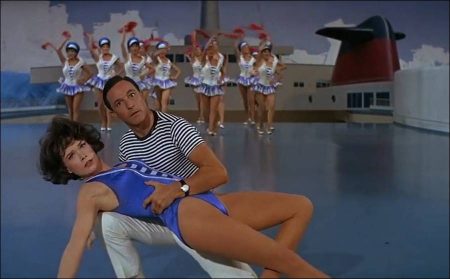What a Way to Go! movie storyline. A woman who wants nothing more than the simple life marries for love and ends up contributing to four husbands gaining fame and wealth – and ultimately dying. She is convinced she is cursed, and tries to give her millions to the U.S. Treasury. She’s refused, all the way up the chain of command to the President. As a result, she’s sent to see a psychiatrist.
In a dream-like pre-credit sequence, Louisa May Foster, dressed as a black-clad widow, descends a pink staircase in a pink mansion. As she reaches the bottom, she is followed by pall-bearers carrying a pink coffin. As they round the bend in the staircase, the pallbearers drop the coffin, which slides down the stairs, leading into the opening titles.
Louisa tries to give away more than $200 million to the US government Internal Revenue Service, which believes it to be a joke for April Fools’ Day. Louisa ends up sobbing on the couch of an unstable psychiatrist, Dr. Steffanson, and tries to explain her motivation for giving away all that money, leading into a series of flashbacks combined with occasional fantasies from Louisa’s point of view.
We meet Louisa as a young, idealistic girl. Her mother, fixated on money, pushes for Louisa to marry Leonard Crawley, the richest man in town. Louisa instead chooses Edgar Hopper, an old school friend who, inspired by Henry David Thoreau, lives a simple life. They marry and are poor but happy, shown through a silent film spoof with the underlying motif that “Love Conquers All”. Their life is idyllic until Hopper, hurt and angry by Crawley’s ridiculing how they live, decides to aim for success. Neglecting Louisa in order to provide a better life for her, he builds his small store into a tremendous empire, running Crawley out of business. In so doing, Hopper literally works himself to death.
Now a millionaire, Louisa vows never to marry again. She travels to Paris, where she meets Larry Flint, an avant-garde artist who is driving a taxi. Louisa falls in love with Flint, and they marry, living an idyllic life and bohemian lifestyle, shown through a foreign-film spoof. Flint invents a machine which converts sounds into paint on canvas. He plays eclectic sounds producing random art.
One day, Louisa plays classical music, and it produces a beautiful painting which Flint sells (his first significant sale). Buoyed by success, he creates more and more paintings, becoming hugely successful. Obsessed now, he builds larger machines to do the painting. Flint relentlessly produces art until, one night, the machines turn on their creator and beat him to death.
Even richer but more depressed, Louisa decides to return to the United States. She misses her flight, but meets Rod Anderson Jr., a well-known business tycoon. He offers her a lift on his jet. At first, she finds him cold and calculating, but Louisa sees his softer side on the flight.
They are married shortly after landing, and they live a lush and idyllic life, depicted through a fantasy sequence spoofing the glamorous big-budget films of the 1950s. Fearful of losing him like her first two husbands if he threw himself back into his work, Louisa convinces Rod to sell everything and retire to a small farm. After sharing a jug with a few locals, an inebriated Rod mistakenly attempts to milk a bull, who kicks him through the wall of the barn, leaving Louisa a widow again.
What a Way to Go! is a 1964 American black comedy film directed by J. Lee Thompson and starring Shirley MacLaine, Paul Newman, Robert Mitchum, Dean Martin, Gene Kelly, Bob Cummings, Dick Van Dyke, Reginald Gardiner, Margaret Dumont, Lou Nova, Wally Vernon, Maurice Marsac and Jane Wald.
What a Way to Go! (1964)
Directed by: J. Lee Thompson
Starring: Shirley MacLaine, Paul Newman, Robert Mitchum, Dean Martin, Gene Kelly, Bob Cummings, Dick Van Dyke, Reginald Gardiner, Margaret Dumont, Lou Nova, Wally Vernon, Maurice Marsac, Jane Wald
Screenplay by: Betty Comden, Adolph Green
Cinematography by: Leon Shamroy
Film Editing by: Marjorie Fowler
Set Decoration by: Stuart A. Reiss, Walter M. Scott
Art Direction by: Ted Haworth, Jack Martin Smith
Music by: Nelson Riddle
MPAA Rating: None.
Distributed by: 20th Century Fox
Release Date: May 14, 1964 (New York City)
Views: 277


